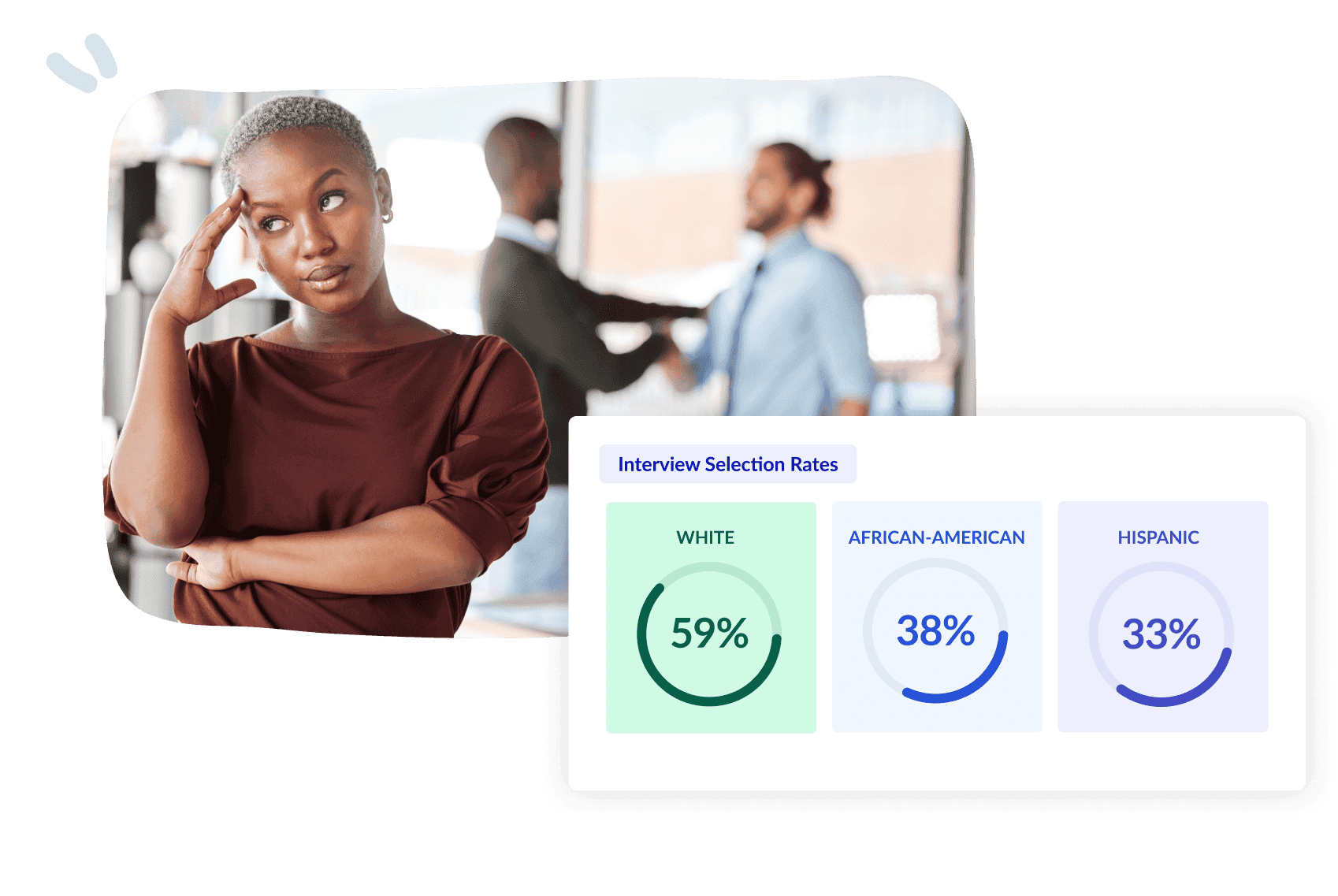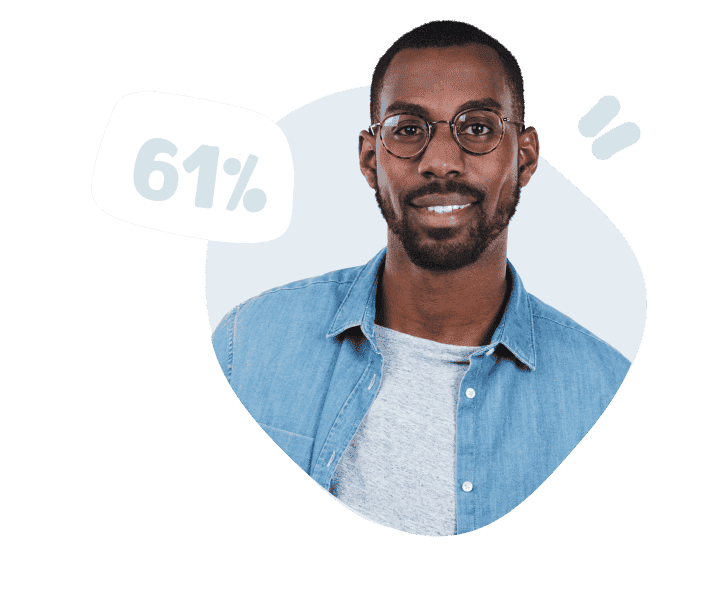
How To Conduct a Structured Interview
Learn how to conduct structured interviews effectively with our comprehensive guide.

Adverse impact is a form of employment discrimination that has a negative effect on diversity-identified groups. It poses challenges to fairness and equality and often isn’t easy to pinpoint. Adverse impact is a complex issue where well-intentioned but ineffective HR policies become part of the problem.
What can you do to mitigate adverse impact? Read on to learn how to calculate adverse impact using the four-fifths rule, how it contributes to discrimination in the workplace, and how to minimize the risks.
The term adverse impact refers to seemingly neutral practices that may disadvantage certain groups of people based on specific characteristics. These groups of people are called protected groups. This form of unintentional discrimination can occur when a policy, though fair in form, is discriminatory in practice.
In the US, the Equal Employment Opportunity Commission (EEOC) defines protected groups as:
“Applicants, employees and former employees are protected from employment discrimination based on race, color, religion, sex (including pregnancy, sexual orientation, or gender identity), national origin, age (40 or older), disability and genetic information (including family medical history).”
In the context of employment, adverse impact can manifest at any stage of the employment process, from recruitment and hiring to promotions and terminations.
Here are some examples of pre- and post-employment policies that are problematic:
1. Educational Requirements
Consider a job posting that requires candidates to hold a specific degree or a certain level of education, even though the skills required for the job could be gained through relevant work experience. This requirement might inadvertently disadvantage individuals from lower socio-economic backgrounds who may not have had access to higher education but have the necessary skills and experience.
2. Physical Fitness Tests
Many companies require physical fitness tests as part of their recruitment process. While this may be relevant for some roles, it may be an unnecessary barrier that can create accessibility concerns.
3. Last In, First Out
During layoffs, some companies use a “last in, first out” policy, where the most recently hired employees are the first to be let go. While this may seem fair on the surface, it could disproportionately affect younger workers or those who change jobs more frequently.
In each of these cases, the policies are not inherently discriminatory, but their implementation can lead to unequal outcomes for different groups. Regularly review your policies and practices and bring in a DEI consultant — if possible — to get an alternative perspective. They can help identify and address problems that may arise.

A hiring process that minimizes adverse impact creates a diverse and inclusive workplace. When all applicants have an equal opportunity to succeed, organizations can attract a wider range of talent. The most important thing to note here is that this issue in hiring can stem from two different places.
The first is policies that disproportionately disqualify some groups, like the educational and physical fitness examples mentioned above. The second are biases that your team may have and hold subconsciously.
Addressing this can make all the difference to your organization and improve candidate experience significantly. Prospective employees are increasingly seeking out employers who value diversity, equity, and inclusion (DEI).
How to stand out in a competitive market
According to a CNBC survey, 80% of people say they want to work for a company that values DEI efforts. Don’t be afraid to rework your policies and demonstrate your commitment to being an equal opportunity employer.

Understanding the difference between adverse impact and disparate treatment is crucial for organizations striving for fairness and equality. Disparate treatment refers to explicit, intentional discrimination of an individual or a group because of a protected characteristic. This form of discrimination is generally more visible and easier to address due to its overt nature.
Adverse impact, which is unintentional discrimination, requires a more proactive, analytical approach to identify. Left unchecked, it can be an issue that continues to grow, negatively impacting those in your organization and society at large.
Both forms of discrimination can lead to consequences and reputational damage. More importantly, they impact DEI. By staying vigilant about both overt and covert forms of discrimination, organizations can ensure a more equitable environment where every employee has equal opportunities.
Did you know about 3 out of 5 employees have experienced or witnessed some form of workplace discrimination?
That’s 61% — and that’s just what’s reported (Glassdoor)! Discrimination is the enemy of a healthy, productive workplace.

An adverse impact analysis uses organizational data to uncover potentially discriminatory practices in your operations. Ideally, this should be done once a year.
Calculating adverse impact requires you to create a list of your organization’s policies and practices and collect relevant data.
From there, there are several methods you can use to measure statistical significance. The most common way to identify instances where protected groups are disproportionately affected is by using the four-fifths rule (4/5 rule), which is straight from the EEOC’s Uniform Guidelines on Employee Selection Procedures.
The four-fifths rule is an equation that can help you determine if there is evidence of adverse impact. If an organization finds that the selection rate of a protected group is less than 80% of the selection rate when compared to a different group, it may suggest that there’s an adverse impact.
This rule does not provide definitive proof of discrimination. Instead, it’s an indicator that further investigation is needed. It prompts organizations to examine their hiring practices and policies to uncover potential barriers. The four-fifths rule highlights places where progress is possible.
The rise of artificial intelligence (AI) in the recruitment and selection process is raising new concerns. AI has the ability to streamline HR practices. However, it also has the potential to mirror and perpetuate hiring biases.
One area where AI can particularly shine is in the organization and analysis of structured interviews. By analyzing responses and assisting in the comparison of candidates, AI can help HR professionals make more informed, unbiased decisions.
On the flip side, the algorithms that power AI are trained on existing data. If these data reflect societal or systemic biases, then the AI may inadvertently continue patterns of discrimination. For example, if the AI is trained using a dataset of successful employees who are predominantly from one race or gender, it may unintentionally favor candidates who fit that profile.
This is a reason why AI should complement, not replace, human decision-making. It’s crucial for organizations to use AI responsibly and ethically. The decisions reached using any AI tools must be reviewed and assessed regularly for adverse impact.
Discrimination in the workplace, intentional or not, is governed by laws and regulations that exist in jurisdictions worldwide. These laws prohibit employment discrimination based on a variety of factors. Adverse impact may lead to legal action against an organization if practices are found to discriminate against a protected group.
Cases can be brought to light by individuals or by regulatory bodies like the EEOC.
The potential ramifications include financial penalties, mandated changes to recruitment and employment practices, and reputational damage. Organizations must understand the risks and work to minimize them as much as possible.
Discrimination is up almost 20% year-over-year
In 2022, the EEOC received 73,485 new discrimination charges. That’s almost a 20% increase from the previous fiscal year.
Here are some strategies you can employ to minimize adverse impact in your hiring process:
Evaluating based on competencies (the essential qualifications for a job) directly relates to job performance. Education details and background information could add opportunities for bias to influence selection. Establish a standardized interview scorecard for each position to avoid subjectivity.
Avoid filtering out candidates who may be turned away by specific terms in the job descriptions or may perform poorly on questions that may present a cultural disadvantage.
Some elements of the interview process may not be accessible, creating barriers that prevent candidates from completing an interview or applying for the job. Offering video interviewing options is an easy way to save candidates time and money on travel-related costs, include remote candidates, and provide interview accommodations. Video interviewing software empowers job seekers with a flexible, more equitable, process.
The best way to ensure you are being inclusive is to invite more people into your hiring process. Expanding your geographical focus and promoting role openings in areas that lie outside of traditional recruiting channels is a great way to increase the diversity of your candidate pool.
The only way to be sure your process is inclusive and equitable to all is by performing regular audits (at least once a year or significantly more if you use AI) as described above. When you see something, do something. Use your Applicant Tracking System to collect data and use it to evaluate what particular stage may be disproportionately eliminating candidates who may share a particular characteristic or identify as a particular group.

Addressing and changing problematic policies goes beyond preventing legal issues. When you prove adverse impact, you are shining a light on unintentional barriers that find their way into well-intentioned policies.
It’s time for employers to take a closer look at their policies and practices. Review your hiring processes, use AI responsibly, and promote ongoing diversity and inclusion training. Remember, you have the power to contribute to an environment where everyone gets their fair shot at success.
As we move forward, you can shape the future of employment. By understanding and addressing adverse impact, you can create a workplace culture that not only celebrates diversity but thrives because of it. All while attracting a wider range of talent, sparking innovation, and standing out.
In addition to the adverse impact examples provided above, here are some other instances where it can sneak into the hiring process:
Adverse impact and disparate impact are both related to Title VII of the Civil Rights Act, but they are not the same (EEOC).
Under Title VII, disparate impact prohibits employers from using employment practices that have an unintentional but disproportionately negative effect (adverse impact) on members of a protected class. Disparate impact is essentially the legal theory that holds employers liable for adverse impact.
Adverse impact quantifies this negative effect, but on its own, does not constitute discrimination — it only indicates the potential for discrimination.
Disparate impact isn’t intentional, whereas disparate treatment is an intentional decision to treat a group of people or an individual differently based on a protected characteristic. Disparate impact is measured via adverse impact, while disparate treatment required proof of intention.
Modernize your hiring process with expert insights and advice.